Related Research Articles
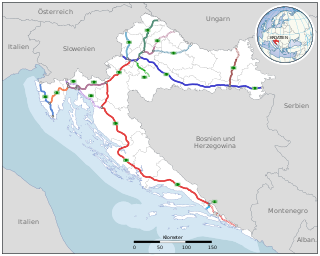
Transport in Croatia relies on several main modes, including transport by car, train, boat and plane. Road transport incorporates a comprehensive network of state, county and local routes augmented by a network of highways for long-distance travelling. Water transport can be divided into sea, based on the ports of Rijeka, Ploče, Split and Zadar, and river transport, based on Sava, Danube and, to a lesser extent, Drava. Croatia has 68 airports, nine of which are international. The country also has several airlines, of which the most notable are Croatia Airlines and Trade Air. Rail transport is fairly developed, with dual track and electrification not very common, although high-speed tilting trains are used on some routes. However, bus still tends to be more common than rail as a mode of inter-city transport.
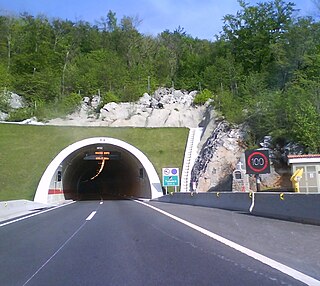
Tuhobić Tunnel is one of the most significant structures on the Croatian A6 motorway route. As it is 2,143 metres (7,031 ft) long, Tuhobić Tunnel is the longest tunnel on the A6 motorway route. The tunnel is located at 700 metres (2,300 ft) above sea level, connecting the Gorski Kotar and Croatian Littoral regions. The tunnel is located between the Vrata and Oštrovica interchanges.

The Brinje Tunnel is a four-lane tunnel in Croatia, an integral part of the A1 motorway located between Brinje and Žuta Lokva interchanges. The Brinje Tunnel is located immediately to the south of the Mala Kapela Tunnel, the longest tunnel in Croatia.

Mala Kapela Tunnel is the most significant structure on the Croatian A1 motorway route. As it is 5,821 metres (19,098 ft) long, Mala Kapela Tunnel is the longest tunnel in Croatia. The tunnel is geographically located between the villages of Jezerane and Modruš, and between Ogulin and Brinje motorway interchanges. The tunnel passes through the Mala Kapela mountain in the northeast-southwest direction. The first tunnel tube through the Mala Kapela mountain was completed in 2005, and was used for both directions of traffic until the second tube was completed in 2009.

European route E73 forms part of the United Nations International E-road network, connecting Hungary and eastern Croatia to Bosnia and Herzegovina and the Adriatic Sea in the vicinity of the port of Ploče. This 679-kilometre (422 mi) route is also designated as the Pan-European Corridor Vc, a branch of the fifth Pan-European corridor. The route largely consists of two-lane roads with at-grade intersections, although in the 2000s, about a third of the route was upgraded to motorway standards. The remainder of the route is currently being upgraded in all the countries spanned. The longest part of this corridor goes through Bosnia and Herzegovina and is widely touted as a road instrumental to the development of the country. The road also serves as the shortest connection of the eastern and southern parts of Croatia.

The A1 motorway is the longest motorway in Croatia, spanning 476.3 kilometers (296.0 mi). As it connects the nation's capital Zagreb to the second largest city Split, the motorway represents a major north–south transportation corridor in Croatia and a significant part of the Adriatic–Ionian motorway. Apart from Zagreb and Split, the A1 motorway runs near a number of major Croatian cities, provides access to several national parks or nature parks, world heritage sites, and numerous resorts, especially along the Adriatic Coast. National significance of the motorway is reflected through its positive economic impact on the cities and towns it connects as well as its importance to tourism in Croatia.
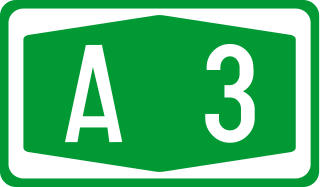
The A3 motorway is a major motorway in Croatia spanning 306.5 kilometres (190.5 mi). The motorway connects Zagreb, the nation's capital, to the Slavonia region and a number of cities along the Sava River. It represents a major east–west transportation corridor in Croatia and a significant part of the Pan-European Corridor X, serving as a transit route between the European Union states and the Balkans. Apart from Zagreb, where the A3 motorway comprises a considerable part of the Zagreb bypass, the motorway runs near a number of significant Croatian cities. The motorway has a positive economic impact on the cities and towns it connects, and is an important route within Croatia.

The A2 motorway is a motorway in the Hrvatsko Zagorje region of northern Croatia, connecting Zagreb to the Macelj border crossing and Slovenia. The A2 motorway is part of the European route E59 and the Pan-European Corridor Xa. The motorway spans 59.2 kilometres (36.8 mi) between the Slovenian border and the Jankomir interchange within the Zagreb bypass, providing road connections to a number of cities and towns besides Zagreb, including Krapina, Zabok and Zaprešić. All sections of the motorway, except the northernmost one between the Macelj border crossing and Trakošćan, and the southernmost one near Zagreb, are tolled, using a closed toll collection system.

The A4 motorway is a motorway in Croatia spanning 97.0 kilometres (60.3 mi). It connects the nation's capital, Zagreb, to the city of Varaždin and to Budapest, Hungary via the Goričan border crossing. The motorway represents a major north–south transportation corridor in Croatia and is a part of European routes E65 and E71. The A4 motorway route also follows Pan-European corridor Vb.

The A5 motorway is a motorway in Croatia spanning 59 kilometres (37 mi). It connects Osijek, the largest city in Slavonia region, to the Croatian motorway network at the Sredanci interchange of the A3 motorway. The A5 represents a significant north–south transportation corridor in Croatia and is a part of the European route E73. The A5 motorway route also follows Pan-European corridor Vc. In addition to Osijek, the A5 motorway also passes near Đakovo.

The A6 motorway is a motorway in Croatia spanning 80.2 kilometres (49.8 mi). It connects the nation's capital, Zagreb, via the A1, to the seaport of Rijeka. The motorway forms a major north–south transportation corridor in Croatia and is a part of European route E65 Nagykanizsa–Zagreb–Rijeka–Zadar–Split–Dubrovnik–Podgorica. The A6 motorway route also follows Pan-European corridor Vb.

The A7 motorway is a 42.4-kilometre-long (26.3 mi) motorway in Croatia. It connects the nation's largest port in Rijeka, to the Croatian motorway network, as well as to the Rupa and Pasjak border crossings to Slovenia. The motorway forms part of a longitudinal transportation corridor in Croatia, and it is a part of European route E61 Villach–Ljubljana–Trieste–Rijeka. The A7 motorway route south of Orehovica interchange, where it also intersects Pan-European corridor Vb, is a part of European route E65.

The A8 motorway is a 64.0-kilometre (39.8 mi) toll motorway in Croatia. It connects the A7 motorway near Rijeka with the road network in the Istrian peninsula via the Učka Tunnel. The road terminates at the Kanfanar interchange with the A9 motorway, which with the A8 motorway forms the Istrian Y road system. The motorway's national significance is reflected in its positive economic impact on the cities and towns it connects, as well as its importance to tourism in Croatia. The importance of the motorway for tourism is particularly high during the summer tourist season, when its traffic volume increases by about 65%.

The A9 motorway is a north–south motorway in Croatia, with a length of 78.3 kilometres. Beginning in Pula, the largest city on the Istrian peninsula, it runs north to the Croatian motorway and expressway network at the Kanfanar interchange. Here it meets the A8 motorway, forming the Istrian Y road system. The A9 continues north from here to the Kaštel and Plovanija border crossings into Slovenia. The motorway represents a significant north–south transportation corridor in Croatia and is a part of the European route E751. The motorway's national significance is reflected in the positive economic impact on the cities and towns it connects, as well as its importance to tourism in Croatia. Importance of the motorway for tourism is particularly high during summer tourist seasons, when traffic volume increases by more than 80%.

Highways in Croatia are the main transport network in Croatia. The Croatian classification includes several classes of highways:

The state road D1 is a national highway in Croatia. It is a one-lane highway that spans from Macelj border crossing in the north via Krapina, Zagreb, Karlovac, Slunj, Gračac, Knin, Sinj, ending in Split. It is 421.2 kilometres (261.7 mi) long overall.
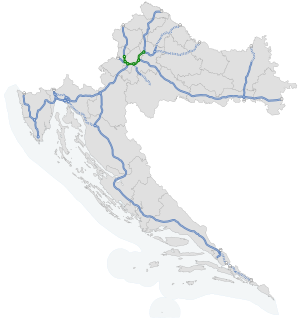
Zagreb bypass is a U-shaped motorway partially encircling Zagreb, Croatia. The largest part by far, between Jankomir and Ivanja Reka interchanges, was built between 1977 and 1979, while the Ivanja Reka – Sveta Helena section was built between 1996 and 1999. The bypass is 48.9 kilometres (30.4 mi) long, tracing around the city from the northwestern suburb of Zaprešić to Sveta Helena in the northeast. The bypass crosses the Sava River twice and comprises a bridge across the Sava-Odra floodwater overflow canal. As the busiest sections between Jankomir and Buzin interchanges carry traffic volume of approximately 45,000 AADT, it is the most heavily used motorway sector in Croatia.
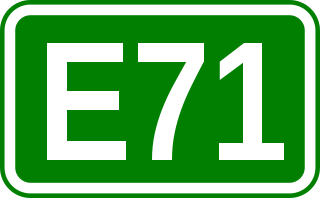
European route E 71 is a north-south Class-A intermediate European road route. It begins in Košice, Slovakia, passes through Budapest in Hungary, Zagreb in Croatia, and ends at Split in Croatia on the Adriatic Sea coast. The total length of the route is 1,016 km (631 mi). The E71 mostly consists of motorways, but considerable sections are either expressways or two-lane roads with at-grade intersections. Nearly all motorway sections of the E71 are tolled, using various toll collection systems including Electronic toll collection (ETC) and ticket systems. Individual segments of the E71 route are shared with several other European routes. The E71 section between Karlovac and Split is inconsistently physically signposted or marked on maps and route planning software. The E71 route has gradually been upgraded from a regular two-lane road to motorway standards since the 1970s; upgrades are still being carried out in some areas.

D425 is a state road in Croatia, connecting the outskirts of Ploče with the A1 motorway connector at the Karamatići toll station. Its main purpose is a connection from the motorway to the Port of Ploče. The road is 9.87 km (6.13 mi) long.

Veliki Gložac Tunnel is one of 13 tunnels found on the Croatian A6 motorway route. It is 1,126 metres (3,694 ft) long and consists of two tunnel tubes. It is located between Vrbovsko and Bosiljevo 2 interchanges. The tunnel is tolled within the A6 motorway closed toll collection system. There are no other toll plazas related to use of the tunnel. Construction of the tunnel was completed by Viadukt and Hidroelektra.
References
- ↑ "Kategorije vozila" [Vehicle categories]. HAK (in Croatian). Retrieved 4 November 2021.
- ↑ "Pravilnik o cestarini" [Toll regulations]. Narodne novine (in Croatian). Ministry of Sea, Transport and Infrastructure. 27 September 2017. Retrieved 4 November 2021.
- ↑ "Propisi" [Regulations]. HUKA (in Croatian). Retrieved 4 November 2021.